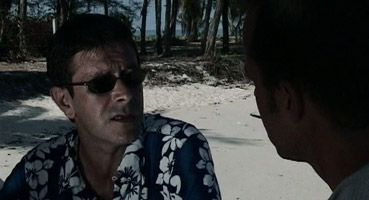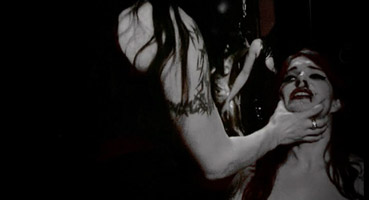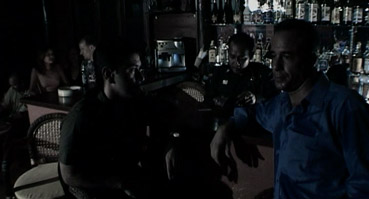|
Before I start, I feel the need to apologise to my patient editor for the lateness of this review. I've had the disc for weeks, and yet putting into words my reaction to the film has given me endless trouble. It's not that the plotting is too complex or too layered for me to get a handle on it, or that there were aspects that flew over my head and needed study and multiple viewings to decipher. No sir. It's just that even after three viewings, I can't decide whether the makers of Nature Morte are an enterprising bunch of enthusiastic first-timers whose do-it-yourself approach to filmmaking deserves encouragement and funding, or a group of misguided amateurs who should be persuaded to find gainful employment in a field better suited to their talents, whatever they may be. If that seems a little harsh, then know that while some of you will be in the former camp, there will be just as many out there who will have no trouble rallying for the latter.
Let's get one thing straight, Nature Morte is constructed around a solid premise. John Stephenson is an artist, but he's also a suspected serial killer. For him, the torture and eventual killing of his young female victims is part of the process of artistic creation, resulting in gruesome portraits whose uniquely disturbing quality have made them objects of fascination in the art world. On the completion of his tenth such work, however, he kills himself, and his body is discovered in a Marseilles house next to that of his final victim. This loss to the art world is society's gain, but when a new set of paintings appear, apparently by the same hand, art dealer Oliver Davenport is asked by French detective Georges to assist with his investigation into their origin. All roads lead to Thailand and the mysterious Lec. Is he a brilliant forger, a talented new artist, or the true perpetrator of the Marseilles killings?

Any problems with that? No sir, me neither. But whether this works on screen is all down to the execution, and that's where you'll either go with the film or find yourself completely detached from it. Or, as in my case, stuck somewhere in the middle.
I think it's probably safe to say that if you like your horror served with glossy production values then Nature Morte is going to give you the technical heebie-jeebies. Those of us who have grown rather fond of the low-budget aesthetic will be a little more tolerant. But only a little. Nature Morte was shot on mini-DV and this is something it never tries to disguise. That's not a problem in itself, as in the hands of Lars von Trier, Thomas Vinterberg, Mike Figgis and Danny Boyle the format has proved to be as valid and exciting a medium as film or high definition. But mini-DV is still essentially a high-end domestic format and does not have the definition, contrast ratio or low light tolerance of its high-band brethren. If you're going to use it effectively then you need a cameraman who knows how to light and shoot with it, hence Boyle's employment of DV-savvy von Trier regular Anthony Dod Mantle for 28 Days Later. I'm sure Slarek, who has done his share of DV camerawork over the years, could rattle on for hours about this (oh don't get me started – Slarek), but Nature Morte rarely looks like it's been lit with the restrictions of DV in mind. It's dark, made darker by some post-production fiddling, but in a way that sometimes makes it hard to see what's happening on screen, especially when there's a lot of movement. How much of this is down to the transfer I cannot say, so a couple of doubt benefits can be handed out here.
But then there's the acting. If the use of DV gives the project a student film look, then some of the performances go a good way to confirming it. Awards are unlikely to be handed to anyone, but there's a strong suspicion that director Paul Burrows skipped the casting call stage and filled up the gaps in the supporting cast with his mates. It's good that they could remember their lines, but would have been nicer if they were able to deliver them with even a hint of emotion or naturalism. In the lead role of Oliver Davenport, newcomer (no kidding) Troy McFadden just about holds his own, but is bested at every turn by Jeso Vial as Georges, especially when allowed to converse in his native tongue. There's even that old student film favourite of a news broadcast delievered by someone who is clearly not a newsreader against a patently non-newsroom backdrop.

But dismiss the film I can't and won't. For all its wobbly performances, iffy handling and a reluctance to go the whole hog on either its erotica or its violence, Nature Morte has an almost indefinable something that kept me watching. Faults aside, the film does have its own peculiar sense of macabre doom, an atmosphere of almost surrealistic unease that the above points of complaint paradoxically contribute to. Stilted conversations take on the quality of those in a waking dream, enhanced by a haunting soundtrack from Arban and Steve Severin and the sense that even daylight scenes are somehow taking place in darkness. And it can be argued without a credibility push that by holding back on excess on scenes that could have been horrifying in their violence, the film sidesteps being labelled as torture porn and tossed into an already overfull genre trashcan.
I'm still not fully convinced, not by a long shot. But the film has certainly found a few fans and wears it's much publicised stamp of approval from Jess Franco as a badge of honour and credibility, one that can't help but cut some ice with us genre fans. In the end, Nature Morte looks exactly like what it probably is, a first film made by amateurs on a microscopic budget using whoever was prepared to lend a hand in any capacity they were needed. But it is built around a solid premise, and just occasionally, as with Oliver's drug trips and flashbacks, shows signs of a visual and aural inventiveness that suggest Burrows may yet make a film whose handling will match the ambition of his ideas.
Shot on mini-DV and framed 1.85:1, possibly cropped from 4:3, the letterboxed transfer adds to the clarity issues caused by the darkness of the print, which has clearly been taken off the video master and I'm guessing doesn't exist in film form. The narrow contrast ratio of DV video means that shadow detail is sometimes non-existent, but except where the picture has been treated in post-production, the sharpness is good and the black levels are certainly solid. The subtitles that are used are pleasingly in the picture area, so you can zoom in without losing information.

The Dolby 2.0 soundtrack is clear and Arban and Steve Severin's music score sounds great, but don't go in expecting complex background sound mixes.
Stills gallery
9 luridly coloured stills and 2 posters.
Behind the scenes stills
7 on-set stills, also colour enhanced, but of slightly more interest than the above.
Deleted & Alternative Scenes (31:28)
Introduced by director Paul Burrows, this will be of real interest to those who are sympathetic to the film and want to see more or view alternative cuts of existing scenes. Included are the original opening sequence and the footage itself is punctuated by background detail from Burrows, which is useful.
Blooper Reel (5:37)
Not as much fun as it sounds, a mixture of fluffed lines, corpsing and larking about, but it has it's amusing moments.
Trailer (2:12)
Interesting to see how the movie was sold.
There's also info on the soundtrack album and the usual Redemption trailers and book teaser.
I'm still undecided on this one. Everyone has to start somewhere and Nature Morte has apparently already led to a second feature for director Burrows, which I'd be genuinely interested to see. If the film feels like an extended student project then maybe that's inevitable, but I've seen enough of those to last me a lifetime, and some of them leave Nature Morte standing in both conviction of performance and technical proficiency. But if the premise appeals you might like to give it a go – it clearly has an appreciative target audience and you might well find yourself part of it.
|